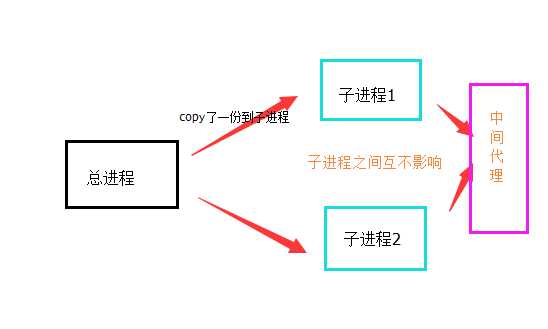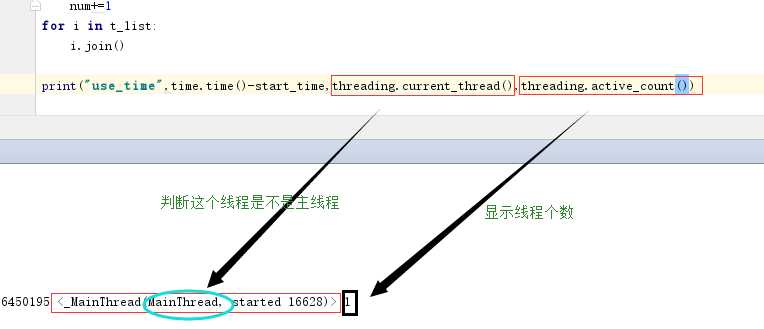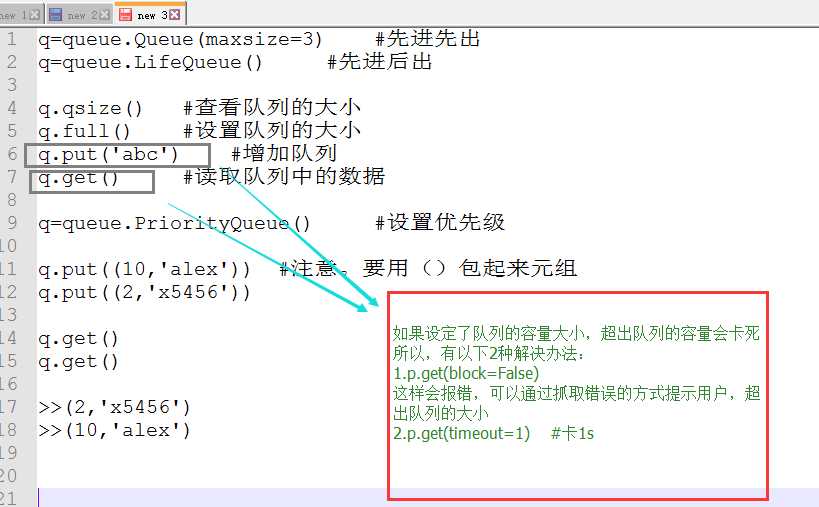python学习——day9(ssh,线程和进程,信号量,队列,生产者消费者模型) Alex地址:http://www.cnblogs.com/alex3714/articles/5230609.ht
Posted
tags:
篇首语:本文由小常识网(cha138.com)小编为大家整理,主要介绍了python学习——day9(ssh,线程和进程,信号量,队列,生产者消费者模型) Alex地址:http://www.cnblogs.com/alex3714/articles/5230609.ht相关的知识,希望对你有一定的参考价值。
一、python上模拟ssh
1.ssh,ssh_ftp
pass
2.ssh 密钥
pass
二、线程,进程
定义:
进程: 是对各种资源管理的集合,qq 要以一个整体的形式暴露给操作系统管理,里面包含对各种资源的调用,内存的管理,网络接口的调用等
线程: 是操作系统最小的调度单位, 是一串指令的集合。
进程要想操作CPU,就必须要创建一个线程(进程中至少包含一个线程)
区别:
1.线程共享内存空间(共享数据等),进程的内存空间是独立的
2.同一进程的线程之间可以相互交流 ,2个进程之间的交流必须通过一个中间代理
3.线程可以操作和控制其他线程(同一进程下),进程只能操作和控制子进程。


对主线程的更改可能会影响到其他线程的工作,对父进程的更改(除非关闭)不会影响子进程。(子进程还可以派生子进程)
各种锁
1.线程锁(我就瞎几把写了一下,具体代码看这:http://www.cnblogs.com/alex3714/articles/5230609.html)


2.递归锁(了解就行,一般用不到)
说白了就是在一个大锁中还要再包含子锁
1 import threading,time 2 3 4 5 def run1(): 6 7 print("grab the first part data") 8 9 lock.acquire() 10 11 global num 12 13 num +=1 14 15 lock.release() 16 17 return num 18 19 def run2(): 20 21 print("grab the second part data") 22 23 lock.acquire() 24 25 global num2 26 27 num2+=1 28 29 lock.release() 30 31 return num2 32 33 def run3(): 34 35 lock.acquire() 36 37 res = run1() 38 39 print(‘--------between run1 and run2-----‘) 40 41 res2 = run2() 42 43 lock.release() 44 45 print(res,res2) 46 47 48 49 50 51 if __name__ == ‘__main__‘: 52 53 54 55 num,num2 = 0,0 56 57 lock = threading.RLock() 58 59 for i in range(10): 60 61 t = threading.Thread(target=run3) 62 63 t.start() 64 65 66 67 while threading.active_count() != 1: 68 69 print(threading.active_count()) 70 71 else: 72 73 print(‘----all threads done---‘) 74 75 print(num,num2)
3.信号量锁(Semaphore)
互斥锁 同时只允许一个线程更改数据,而Semaphore是同时允许一定数量的线程更改数据 ,比如厕所有3个坑,那最多只允许3个人上厕所,后面的人只能等里面有人出来了才能再进去。
1 import threading,time 2 3 def run(n): 4 semaphore.acquire() #信号量锁 5 time.sleep(1) 6 print("run the:",n) 7 semaphore.release() #解锁 8 9 10 if __name__==‘__main__‘: 11 semaphore=threading.BoundedSemaphore(5) #设定只有5个坑 12 for i in range(20): 13 t=threading.Thread(target=run,args=(i,)) 14 t.start() 15 16 while threading.active_count()!=1: 17 pass 18 else: 19 print(‘123‘)
信号量(event)
信号量只有设定(event.set())和没设定(event.clear())两种
event.wait() #等待设定
event.is_set() #判断是否设定
红绿灯例子
1 import time,threading 2 3 event = threading.Event() 4 5 def lighter(): 6 count=0 7 event.set() #设定 8 while True: 9 if count<10 and count>=5: 10 event.clear() #清除设定 11 print("\\033[41;1m红灯\\033[0m") 12 time.sleep(1) 13 elif count>10: 14 count=0 15 event.set() 16 else: 17 print("\\033[42;1m绿灯\\033[0m") 18 time.sleep(1) 19 count+=1 20 21 def car(name): 22 while True: 23 if event.is_set(): #判断是否设定 24 print("\\033[32;1m[%s] run...\\033[0m"%name) 25 time.sleep(1) 26 else: 27 print(‘\\033[31;1m [%s] stop...‘%name) 28 event.wait() #等待设定 29 print(‘\\033[33;1m [%s]走咯‘%name) 30 31 32 light=threading.Thread(target=lighter,) 33 34 light.start() 35 36 car1=threading.Thread(target=car,args=(‘Tesla‘,)) 37 38 car1.start()
未完待续
三、队列(queue)
队列的好处(作用):解耦,提高效率。

生产者消费者模型(很简单,没啥可说的)
1 import threading,time 2 3 import queue 4 5 q = queue.Queue(maxsize=10) 6 7 def Producer(name): 8 count = 1 9 while True: 10 q.put("骨头%s" % count) 11 print("生产了骨头",count) 12 count +=1 13 time.sleep(0.1) 14 15 16 17 def Consumer(name): 18 #while q.qsize()>0: 19 while True: 20 print("[%s] 取到[%s] 并且吃了它..." %(name, q.get())) 21 time.sleep(1) 22 23 24 25 p = threading.Thread(target=Producer,args=("Alex",)) 26 c = threading.Thread(target=Consumer,args=("ChengRonghua",)) 27 c1 = threading.Thread(target=Consumer,args=("王森",)) 28 29 30 p.start() 31 c.start() 32 c1.start()
以上是关于python学习——day9(ssh,线程和进程,信号量,队列,生产者消费者模型) Alex地址:http://www.cnblogs.com/alex3714/articles/5230609.ht的主要内容,如果未能解决你的问题,请参考以下文章